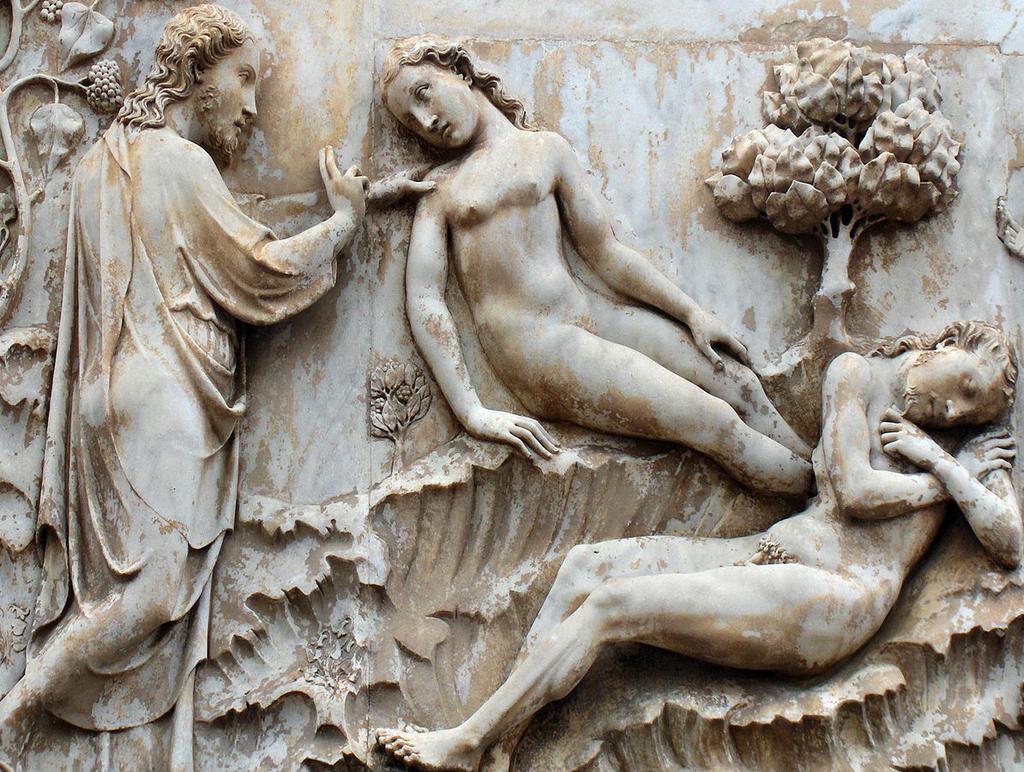
The Adam and Eve Reliefs on the Façade of the Cathedral of the Assumption, Orvieto, Lorenzo Maitani
(כא) וַיַּפֵּל֩ יקוק אֱלֹקִ֧ים ׀ תַּרְדֵּמָ֛ה עַל־הָאָדָ֖ם וַיִּישָׁ֑ן וַיִּקַּ֗ח אַחַת֙ מִצַּלְעֹתָ֔יו וַיִּסְגֹּ֥ר בָּשָׂ֖ר תַּחְתֶּֽנָּה׃
(21) So the GOD cast a deep sleep upon HaAdam; and, while [the Adam] slept, GOD took one of [Adam's] Tzalot and closed up the flesh at that spot.
(ו) וַיִּקַּח אַחַת מִצַּלְעֹתָיו (בראשית ב, כא), רַבִּי שְׁמוּאֵל בַּר נַחְמָן אָמַר מִן סִטְרוֹהִי, הֵיךְ מַה דְּאַתְּ אָמַר (שמות כו, כ): וּלְצֶלַע הַמִּשְׁכָּן. וּשְׁמוּאֵל אָמַר עִלְעָא חָדָא מִבֵּין שְׁתֵּי צַלְעוֹתָיו נָטַל,
(6) "And [GOD] took one of [Adam's]Tzalot." Rabbi Shmuel bar Nachman said: from one of [Adam's] sides, as it says: "And for the side of the tabernacle." (Exodus 26:20).

(יט) וְאַרְבָּעִים֙ אַדְנֵי־כֶ֔סֶף תַּעֲשֶׂ֕ה תַּ֖חַת עֶשְׂרִ֣ים הַקָּ֑רֶשׁ שְׁנֵ֨י אֲדָנִ֜ים תַּֽחַת־הַקֶּ֤רֶשׁ הָאֶחָד֙ לִשְׁתֵּ֣י יְדֹתָ֔יו וּשְׁנֵ֧י אֲדָנִ֛ים תַּֽחַת־הַקֶּ֥רֶשׁ הָאֶחָ֖ד לִשְׁתֵּ֥י יְדֹתָֽיו׃ (כ) וּלְצֶ֧לַע הַמִּשְׁכָּ֛ן הַשֵּׁנִ֖ית לִפְאַ֣ת צָפ֑וֹן עֶשְׂרִ֖ים קָֽרֶשׁ׃ (כא) וְאַרְבָּעִ֥ים אַדְנֵיהֶ֖ם כָּ֑סֶף שְׁנֵ֣י אֲדָנִ֗ים תַּ֚חַת הַקֶּ֣רֶשׁ הָֽאֶחָ֔ד וּשְׁנֵ֣י אֲדָנִ֔ים תַּ֖חַת הַקֶּ֥רֶשׁ הָאֶחָֽד׃ (כב) וּֽלְיַרְכְּתֵ֥י הַמִּשְׁכָּ֖ן יָ֑מָּה תַּעֲשֶׂ֖ה שִׁשָּׁ֥ה קְרָשִֽׁים׃
(19) making forty silver sockets under the twenty planks, two sockets under the one plank for its two tenons and two sockets under each following plank for its two tenons; (20) and for the other Tzela wall of the Tabernacle, on the north side, twenty planks, (21) with their forty silver sockets, two sockets under the one plank and two sockets under each following plank. (22) And for the rear of the Tabernacle, to the west, make six planks;
(20) and for the other Tzela of the Tabernacle, on the north side, twenty planks,
(1) מצלעותיו — The word means of [Adam's] sides, similar to (Exodus 26:20) ולצלע המשכן “and for the second side of the tabernacle”; that is what the Sages said (Eruvin 18a): They were created with two partzufim.

א"ר ירמיה בן אלעזר דיו פרצוף פנים היה לו לאדם הראשון שנאמר (תהלים קלט, ה) אחור וקדם צרתני כתיב (בראשית ב, כב) ויבן יקוק אלקים את הצלע וגו'
Rabbi Yirmeya ben Elazar said: The first adam doubly-front-faced [deyo partzufi panim]. As it is stated: “You have formed me behind and before” (Psalms 139:5). And it is written: “And God fashioned the tzela..." (Genesis 2:22).
(22) And God fashioned the tzela that God had taken from the adam into a woman; and He brought her to the man.

(26) And God said, “Let us make adam in our image, after our likeness. (27) And God created adam in God's image, in the image of God did God created Oto [pronoun 3rd person singular, male/non-specific]; male and female did God created Otam [pronoun 3rd person plural, male/non-specific].
This is the book of the unfolding of humanity from the date God created humanity, created humanity in the likeness of God, male and female God created them, and blessed them and called their name – this male and female creation – Adam, on the day they were created. [my trans]
בֶּן עֲזַאי אוֹמֵר זֶה סֵפֶר תּוֹלְדֹת אָדָם, זֶה כְּלַל גָּדוֹל בַּתּוֹרָה, רַבִּי עֲקִיבָא אוֹמֵר (ויקרא יט, יח): וְאָהַבְתָּ לְרֵעֲךָ כָּמוֹךָ, זֶה כְּלַל גָּדוֹל בַּתּוֹרָה, שֶׁלֹא תֹאמַר הוֹאִיל וְנִתְבַּזֵּיתִי יִתְבַּזֶה חֲבֵרִי עִמִּי, הוֹאִיל וְנִתְקַלַּלְתִּי יִתְקַלֵּל חֲבֵרִי עִמִּי. אָמַר רַבִּי תַּנְחוּמָא אִם עָשִׂיתָ כֵּן דַּע לְמִי אַתָּה מְבַזֶּה בִּדְמוּת אֱלֹקִים עָשָׂה אוֹתוֹ.
Ben Azzai said: “These are the generations of Adam" is a great principle in the Torah. Rabbi Akiva said: "This is a great principle of the Torah: 'You shall love your neighbor as yourself,' (Lev. 19:18). meaning that one should not say, 'Since I am scorned, I should scorn my fellow as well; since I have been cursed, I will curse my fellow as well.'" Rabbi Tanchuma says, “If you do this -- know that God made the person you put to shame in His own image."
(5) Against the outside wall of the House—the outside walls of the House enclosing the Great Hall and the Shrine—he built a storied structure; and he made Tzlaot all around. (6) The lowest story was 5 cubits wide, the middle one 6 cubits wide, and the third 7 cubits wide; for he had provided recesses around the outside of the House so as not to penetrate the walls of the House.
(13) David and his men continued on their way, while Shimi walked on the Tzela of the hill, insulting him as he walked, and throwing stones at him and flinging dirt.
(א) וַ֭יַּעַן בִּלְדַּ֥ד הַשֻּׁחִ֗י וַיֹּאמַֽר׃ (ב) עַד־אָ֤נָה ׀ תְּשִׂימ֣וּן קִנְצֵ֣י לְמִלִּ֑ין תָּ֝בִ֗ינוּ וְאַחַ֥ר נְדַבֵּֽר׃ (ה) גַּ֤ם א֣וֹר רְשָׁעִ֣ים יִדְעָ֑ךְ וְלֹֽא־יִ֝גַּ֗הּ שְׁבִ֣יב אִשּֽׁוֹ׃ (ו) א֭וֹר חָשַׁ֣ךְ בְּאָהֳל֑וֹ וְ֝נֵר֗וֹ עָלָ֥יו יִדְעָֽךְ׃ (ט) יֹאחֵ֣ז בְּעָקֵ֣ב פָּ֑ח יַחֲזֵ֖ק עָלָ֣יו צַמִּֽים׃ (י) טָמ֣וּן בָּאָ֣רֶץ חַבְל֑וֹ וּ֝מַלְכֻּדְתּ֗וֹ עֲלֵ֣י נָתִֽיב׃ (יא) סָ֭בִיב בִּֽעֲתֻ֣הוּ בַלָּה֑וֹת וֶהֱפִיצֻ֥הוּ לְרַגְלָֽיו׃ (יב) יְהִי־רָעֵ֥ב אֹנ֑וֹ וְ֝אֵ֗יד נָכ֥וֹן לְצַלְעֽוֹ׃
(1) Then Bildad the Shuhite said in reply: (2) How long? Put an end to talk! Consider, and then we shall speak. (5) Indeed, the light of the wicked fails; The flame of his fire does not shine. (6) The light in his tent darkens; His lamp fails him.(9) The trap seizes his heel; The noose tightens on him. (10) The rope for him lies hidden on the ground; His snare, on the path. (11) Terrors assault him on all sides And send his feet flying. (12) His progeny hunger; Disaster awaits his Tzela.
His wife, according to the verse, 'and He fashioned ... the Tzela ... for a woman. (Gen 2)
As in 'The side of the Tabernacle'
Septuagint
πτωμα δε αυτω ητοιμασται εξαισιον
vex him with distressing hunger: and a signal destruction has been prepared for him.
Vulgate
adtenuetur fame robur eius et inedia invadat costas illius
His strength shall be wasted with famine, and let hunger invade his ribs
His strengthe be maad feble bi hungur; and pouert asaile hise ribbis.
King James Bible
His strength shall be hungerbitten, and destruction shall be ready at his side.
English Revised Version
His strength shall be hunger-bitten and calamity shall be ready for his halting.
JPS Tanakh 1917
His trouble shall be ravenous, And calamity shall be ready for his fall.
GOD'S WORD Translation
Hunger undermines his strength. Disaster is waiting beside him.
(32) The sun rose upon [Jacob] as he passed Penuel, and he was Tzela-ing on his hip.
Jonathan Lipnik - https://blog.israelbiblicalstudies.com/holy-land-studies/why-was-eve-created-from-adams-rib/
The verb “to limp” (צלע) is taken from the same three letters as “rib” (צלע) because it involves walking on the side, just as the ribs encase the abdomen from the sides.
(10) I heard the whispers of the crowd— Terror all around: “Inform! Let us inform against him!” All the people who [say they wish for] my well-being, the [supposed] guardians of my Tzela are waiting for me to stumble: “Perhaps he can be entrapped, And we can prevail against him And take our vengeance on him.”
They expect my brokenness
(ד) צלעי. ענין חגר ופסח ויאמר על המכשול והתקלה וכן ובצלעי שמחו (תהלים לה):
An issue of being encompassed (=belt) or defect, he is speaking about the stumbling block or trouble - as in the verse ...
(15) But when I Tzela, they gleefully gather; wretches gather against me, I know not why; they tear at me without end.
(6) In that day —declares the LORD— I will assemble the Tzolea, and will gather the outcast And those I have treated harshly; (7) And I will turn the Tzolea into a remnant [this is a good thing!] And the expelled into a populous nation. And the LORD will reign over them on Mount Zion Now and for evermore.


(א) אֵלּוּ טְרֵפוֹת בַּבְּהֵמָה. נְקוּבַת הַוֶּשֶׁט, וּפְסוּקַת הַגַּרְגֶּרֶת, נִקַּב קְרוּם שֶׁל מֹחַ, נִקַּב הַלֵּב לְבֵית חֲלָלוֹ, נִשְׁבְּרָה הַשִּׁדְרָה וְנִפְסַק הַחוּט שֶׁלָּהּ, נִטַּל הַכָּבֵד וְלֹא נִשְׁתַּיֵּר הֵימֶנּוּ כְלוּם, ...רַבִּי יְהוּדָה אוֹמֵר, הַגְּדוֹלָה טֶפַח, וְהַקְּטַנָּה בְּרֻבָּהּ. הַמְסֵס וּבֵית הַכּוֹסוֹת שֶׁנִּקְּבוּ לַחוּץ, נָפְלָה מִן הַגַּג, נִשְׁתַּבְּרוּ רֹב צַלְעוֹתֶיהָ, וּדְרוּסַת הַזְּאֵב. רַבִּי יְהוּדָה אוֹמֵר, דְּרוּסַת הַזְּאֵב בַּדַּקָּה, וּדְרוּסַת אֲרִי בַּגַּסָּה, דְּרוּסַת הַנֵּץ בָּעוֹף הַדַּק, וּדְרוּסַת הַגַּס בָּעוֹף הַגָּס. זֶה הַכְּלָל, כֹּל שֶׁאֵין כָּמוֹהָ חַיָּה, טְרֵפָה:
(1) The following [defects] render cattle terefah:If the esophagus was pierced; If the windpipe severed; If the membrane of the brain was pierced; If the heart was pierced as far as its cavity thereof; If the spine was broken and the cord severed; If the liver was gone and none of it remained...Rabbi Judah says...If the animal fell from the roof; If most of its Tzalaot were fractured; Or if it was mauled by a wolf ...This is the rule: if an animal with a similar defect could not continue to live, it is terefah.

Vulgate Gen 2:22
Immisit ergo Dominus Deus soporem in Adam: cumque obdormisset, tulit unam de costis ejus, et replevit carnem pro ea.
Then the Lord God cast a deep sleep upon Adam: and when he was fast asleep, he took one of his costis, and filled up flesh for it.
Costis – dative / ablative (to/with/by/for/from)
Costarum – Genitive plural (of)

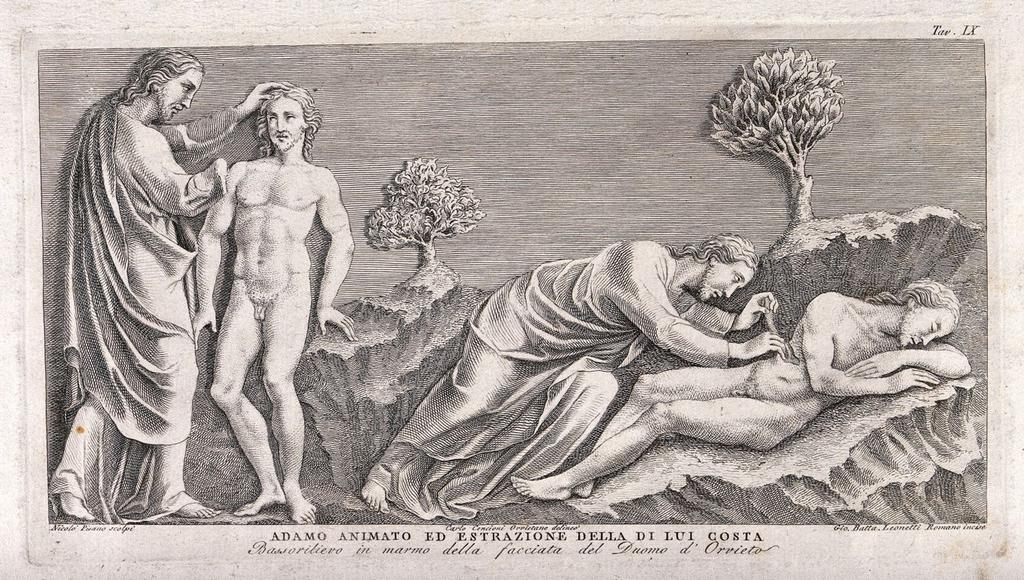
Etching of God operating on Adam to remove his rib. By G.B. Leonetti after C. Cencioni after Nicola Pisano
Plato's Symposium, Speech of Aristophanes c. C4 BCE
In the first place, let me treat of the nature of man and what has happened to it; for the original human nature was not like the present, but different. The sexes were not two as they are now, but originally three in number; there was man, woman, and the union of the two
In the second place, the primeval man was round, his back and sides forming a circle; and he had four hands and four feet, one head with two faces, looking opposite ways, set on a round neck and precisely alike; also four ears, two privy members, and the remainder to correspond. He could walk upright as men now do, backwards or forwards as he pleased, and he could also roll over and over at a great pace, turning on his four hands and four feet, eight in all, like tumblers going over and over with their legs in the air; this was when he wanted to run fast.
Terrible was their might and strength, and the thoughts of their hearts were great, and they made an attack upon the gods; of them is told the tale of Otys and Ephialtes who, as Homer says, dared to scale heaven, and would have laid hands upon the gods... The gods could not suffer their insolence to be unrestrained.
At last, after a good deal of reflection, Zeus discovered a way. He said: "Methinks I have a plan which will humble their pride and improve their manners; men shall continue to exist, but I will cut them in two and then they will be diminished in strength and increased in numbers; this will have the advantage of making them more profitable to us. They shall walk upright on two legs, and if they continue insolent and will not be quiet, I will split them again and they shall hop about on a single leg." He spoke and cut men in two, like a sorb-apple which is halved for pickling, or as you might divide an egg with a hair; and as he cut them one after another, he bade Apollo give the face and the half of the neck a turn in order that the man might contemplate the section of himself: he would thus learn a lesson of humility. Apollo was also bidden to heal their wounds and compose their forms. So he gave a turn to the face and pulled the skin from the sides all over that which in our language is called the belly, like the purses which draw in, and he made one mouth at the centre, which he fastened in a knot (the same which is called the navel); he also moulded the breast and took out most of the wrinkles, much as a shoemaker might smooth leather upon a last; he left a few, however, in the region of the belly and navel, as a memorial of the primeval state. After the division the two parts of man, each desiring his other half, came together, and throwing their arms about one another, entwined in mutual embraces, longing to grow into one, they were on the point of dying from hunger and self-neglect, because they did not like to do anything apart; and when one of the halves died and the other survived, the survivor sought another mate, man or woman as we call them, being the sections of entire men or women, and clung to that.
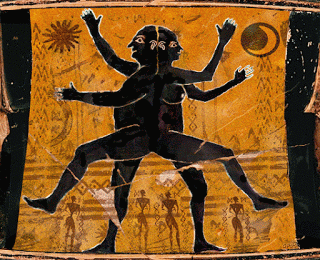
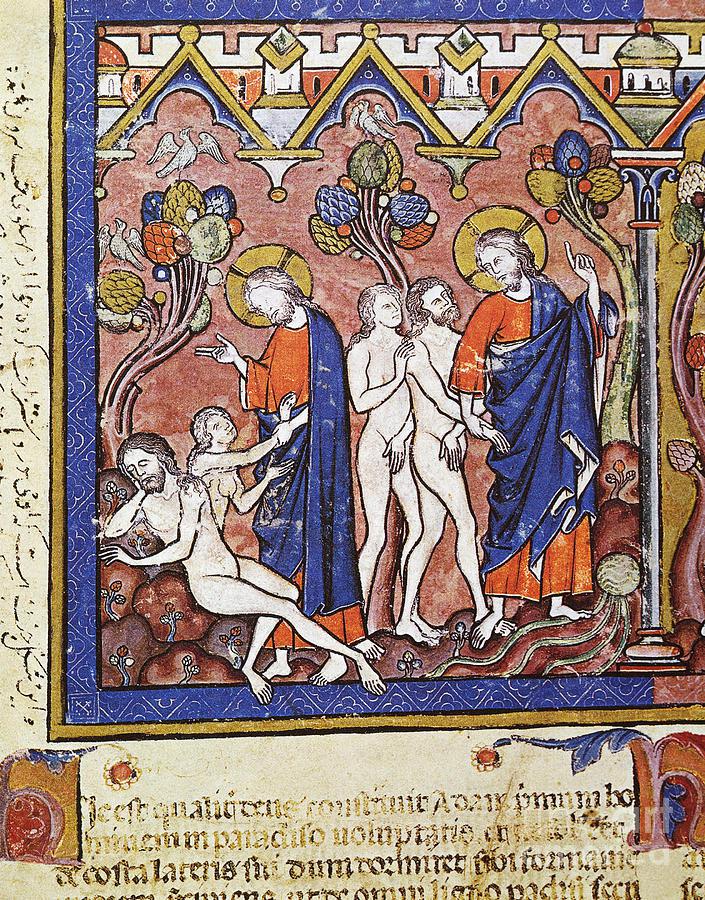
French MS circa 1250

Betram of Minden C14
The Grabow Altarpiece was painted by Master Bertram around 1379-1383. Originally located in St. Petri church, it is now in the Hamburger Kunsthalle in Hamburg, Germany.

Nuremberg Chronicle (Inc.0.A.7.2[888])
The Liber Chronicarum by Hartmann Schedel printed in Nuremberg by Anton Koberger in 1493, or Nuremberg Chronicle as it is generally called, is one of the most important German incunables and the most extensively illustrated book of the 15th century.

Illuminated border in collection of Getty Museum, Simon Bening (Flemmish 1483-1561)
Magnificently clothed in red robes and a three-tiered crown, God calls forth Eve in the idyllic setting of the Garden of Eden. Christian commentators associated Eve's emergence from Adam's side with Christ's side being pierced by a lance, discussed in the text on this page and pictured on the facing folio.


Bible moralisèe: “The Creation of Eve” and “The Birth of Ecclesia,” fol. 2v (detail), ONB Han. Cod. 2554, Österreichische Nationalbibliothek, Vienna. Made in Paris, 1225–49.
Victoria Emily Jones
http://www.artway.eu/content.php?id=2438&action=show&lang=en
Bibles moralisées (moralized Bibles) are lavish picture books originating in thirteenth-century France that pair episodes from scripture with allegorical interpretations—image interpreting image. Captions are given, but the pictures dominate and do the main interpretive work.
The Bible moralisée known as Vienna 2554 from the Austrian National Library is the most famous and one of the earliest of what is a relatively small genre. Each of its thousand-plus miniatures is framed within a medallion, a presentation common to Gothic stained glass, which are then arranged on each page into two parallel columns of four. A top-right detail from folio 2v is shown above: the Creation of Eve as a prefiguration of the Birth of the Church.
The Bible itself allows for this extrapolation, as when, for example, God says in Isaiah 42:14, “I will cry out like a woman in labor; I will gasp and pant,” a possible prophecy of the pangs Jesus would endure on the cross. And John’s mention of the “blood and water” that gushed from Christ’s side wound could allude to the amniotic fluids of birth. Eighteenth-century Moravian piety centralized the importance of the side wound as a symbol of salvation, lauding it as a “motherly womb,” [2] a descriptor reinforced by the many devotional images Moravians produced of the wound isolated from Christ’s body and resembling female anatomy. (This had precedence in late medieval French and English manuscripts.
But not only is Christ our mother, he is also our spouse, much like Adam was both “mother” and spouse to Eve. Just as the first Eve sprung to life from a tear in her husband’s flesh, so did the church come into being out of the torn flesh of Christ. Were it not for Christ’s death, our union with him would not be possible; the church would not exist.
Ephesians 5
25 Husbands, love your wives, just as Christ loved the church and gave himself up for her 26 to make her holy. In this same way, husbands ought to love their wives as their own bodies. He who loves his wife loves himself. 29 After all, no one ever hated their own body, but they feed and care for their body, just as Christ does the church— 30 for we are members of his body.31 “For this reason a man will leave his father and mother and be united to his wife, and the two will become one flesh.” (Gen 2:24) This is a profound mystery—but I am talking about Christ and the church.

Breugel the Younger C17
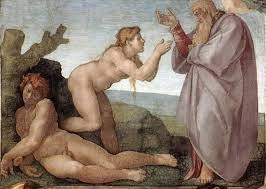
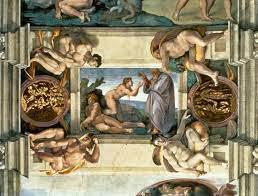
Michelangelo, Sistine Chapel, C16

Creation of Eve, 1950
Leon Underwood, d. 1975 (influence on Henry Moore)

To: Alison Price <[email protected]>
Subject: Leon Underwood - Birth of Eve 1929
Hi,
I’ve been looking at Leon Underwood’s Birth of Eve and would love to know the view from the other direction from the photo on-line.
Is that something you can help with?
Where is the work? If it is viewable in London, I would love to see it. Or are there other photographs available?
There is a history in the Christian artistic presentation of the creation of the first woman as a homunculus – a sort of subsidiary human being built up from the dominant figure of a sleeping Adam. But there is a tradition in Rabbinic Biblical commentary that the first human being was a bi-gendered singular creation comprising of both male and female parts that were split into two equal second humans; one male and one female. That’s based on an understanding of the Hebrew word ‘Tzela’ (often translated as ‘rib’) actually meaning a ‘side.’ It suggests an entirely different aetiology of women – and one much less disagreeable than the notion that women are created sub-man.
It looks, both from the Birth of Eve that you hold, and another Underwood work, that Underwood might have been aware of that rabbinic tradition – which also has a foothold in Plato’s Symposium. But it’s not clear from the view of the sculpture on your site.

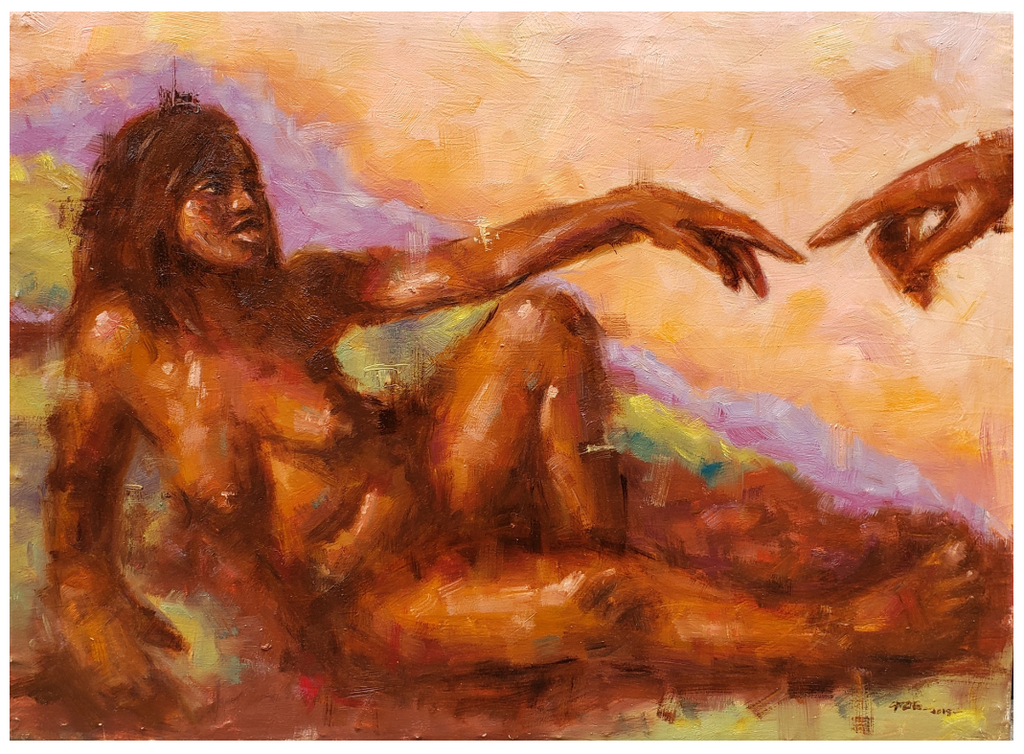

Obi Chigozie, b. 1997, Lagos



Marsha Rowe and Rosie Boycott in the Spare Rib offices, 1972. Photograph: David Wilkerson
Interview with Marsha Rowe
Creative Review 28/5/2015
The name Spare Rib started as a joke, with its play on words about the Biblical Eve fashioned out of Adam’s rib, implying that a woman had no independence from the beginning of time. This held the witty, subversive connotations we had been looking for. Once Rosie [Boycott, co-founder] had agreed with me on the name, she and I worked with two designers, Kate Hepburn and Sally Doust, who created the overall design of the magazine.


